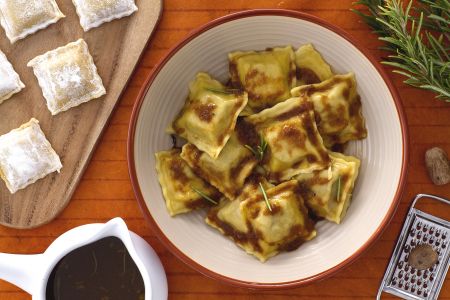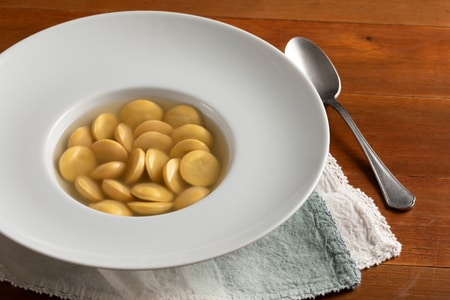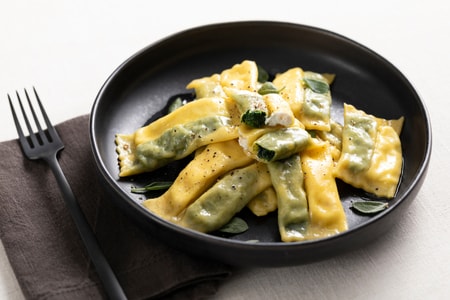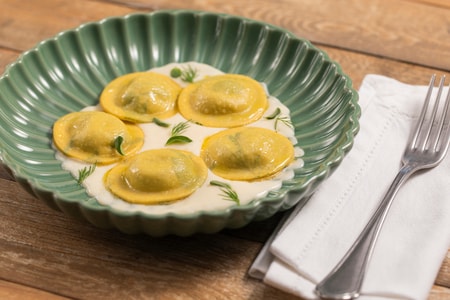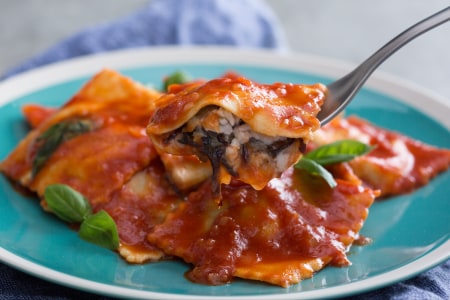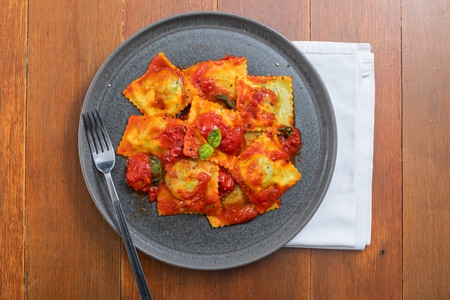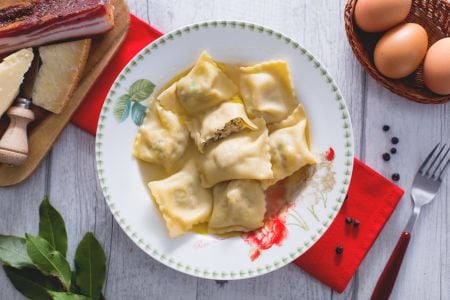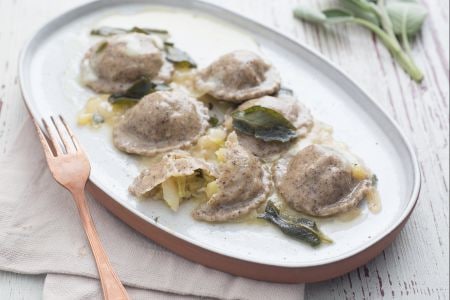Ravioli del Plin
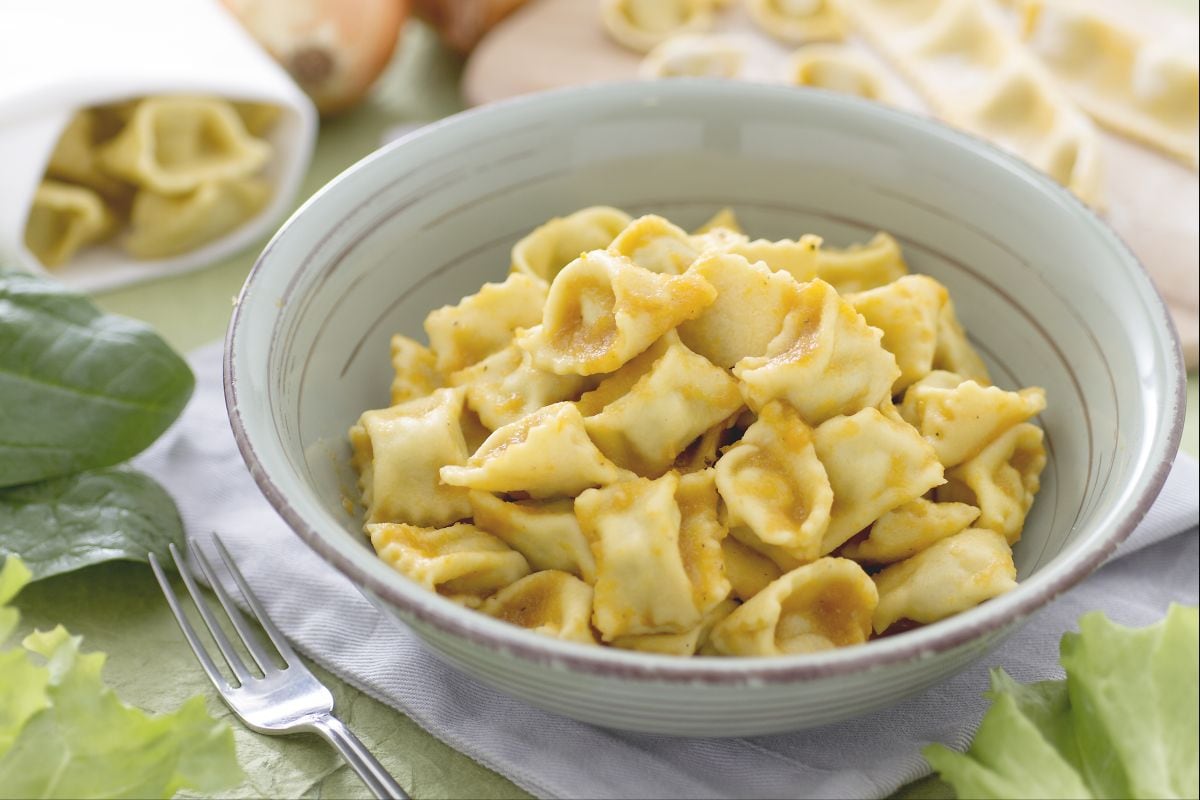
- Lactose Free
- Energy Kcal 337
- Carbohydrates g 33.7
- of which sugars g 4.9
- Protein g 27.5
- Fats g 10.3
- of which saturated fat g 3.63
- Fiber g 2.6
- Cholesterol mg 206
- Sodium mg 412
- Difficulty: Average
- Prep time: 2 h
- Cook time: 1 h 30 min
- Serving: 8
- Cost: Average
- Note plus 1 hour of pasta resting time
PRESENTATION
Ravioli del Plin are a Piedmontese first course made with fresh egg pasta filled with meat and vegetables. Ravioli del plin originated in the Langhe, Monferrato, and Roero regions in the twentieth century as a variant of the classic square ravioli, where they are also called 'raviole' in the feminine form. Ravioli del Plin are smaller than the traditional ravioli and agnolotti. The term 'plin,' which means 'pinch' in the Piedmontese dialect, refers to the characteristic gesture of pinching the pasta with fingers to enclose the filling between one ravioli and the next. Once the pasta is rolled out, small hazelnuts of filling are distributed, then the sheet is folded and the typical 'plin' is applied to seal the pasta, forming small pockets that make these ravioli particularly suitable for holding sauce.
The recipe, which involves using a mix of stewed meats, was originally created to reuse leftover meats in a time when nothing was wasted.
The ravioli del plin recipe we propose involves preparing fresh egg pasta that is rolled out into a thin sheet and then filled with a rich mixture of stewed mixed meats (veal, pork, and rabbit) along with carrots, onions, and celery, enriched with sautéed spinach and escarole. Once ready, the ravioli are topped with the sauce made from the cooked meats and vegetables. There are other variations of this recipe that use savoy cabbage for the filling and a simple seasoning with butter, sage, and Parmigiano Reggiano. For more refined palates, ravioli del plin can be dressed with melted butter and a grating of white truffle, a typical product of the Alba area. Don't miss the version of ravioli del plin with brown sauce!
Here are some other Piedmontese recipes you must try:
- Braised Beef in Barolo
- Tajarin with 30 Egg Yolks and Sausage Ragout
- Ris and Coi Ravioli
- Val Varaita Gnocchi
- Agnolotti
INGREDIENTS
- Ingredients for about 200 ravioli
- Type 00 flour 3 ¼ cups (400 g)
- Eggs 4 - (about 70 g each)
- Ingredients for the filling
- Pork loin 7.1 oz (200 g)
- Veal 9 oz (250 g) - meat
- Rabbit ribs 7.1 oz (200 g)
- Carrots 10.6 oz (300 g)
- Celery 3.5 oz (100 g)
- Onions 1 - large
- Spinach 1 cup (30 g)
- Escarole (endive) 1.1 oz (30 g)
- Eggs 1
- Parmigiano Reggiano PDO cheese 0.5 oz (15 g) - to be grated
- Fine salt to taste
- Black pepper to taste
- Vegetable broth to taste
- Extra virgin olive oil to taste
How to prepare Ravioli del Plin

To make ravioli del plin, first prepare the egg pasta according to the instructions found here. Place the flour on your work surface, make a well in the center, and crack the eggs into it one at a time 1. Starting from the inside, mix the eggs with a spoon; then work the dough with your hands or a fork, incorporating all the flour on the work surface. If the dough doesn't fully incorporate the flour or seems a bit hard, add one or two tablespoons of lukewarm water and continue kneading until the dough is smooth and compact 2. Cover the dough well with plastic wrap 3 and let it rest in a cool, dry place for 1 hour.

Roughly chop the carrots 4, celery, and onion, and set them aside. Trim the fat from the pork loin 5 and veal 6 or ask your butcher to trim the meat for you, removing the fatty parts.

In a large pot, heat a few tablespoons of oil and brown the pork loin and veal 7 until well browned. In another pan, brown the rabbit thighs with two tablespoons of oil 8. Once well browned, combine all the meats in a single pot and add the carrots, celery, and onion 9. Season with salt and pepper and add a ladle of broth or water (for broth preparation, you can refer to the page vegetable broth from our cooking school), cover, and cook for about an hour. If necessary, add more broth or water during cooking.

When the meats are cooked, remove them and let them cool 10. Set aside the vegetables with the cooking liquid, which will be used to dress the ravioli. Meanwhile, cook the spinach 11 and escarole 12 separately in a pan with a drizzle of oil until wilted (about 5 minutes). If you prefer, you can cook the spinach and escarole together, cooking the escarole for a couple of minutes first and then adding the spinach, which requires less time.

Meanwhile, debone the rabbit and cut the pork loin and veal into pieces, place all the meats into a blender 13, chop them finely, then add the egg 14, the vegetables 15, and the cheese. Adjust the seasoning with salt and pepper, and if necessary, add a little broth.

Blend all the ingredients until you obtain a very dense and compact filling 16. Now prepare the ravioli del plin: take a portion of dough (being careful to wrap the rest of the dough in plastic wrap so it doesn't dry out) and roll out a thin sheet 17; you can refer to the page How to Roll Out the Dough from our cooking school. Place a ball of filling about 0.7 oz (20 g) on the lower half of the sheet, leaving a space of 3/8-3/4 inches (1-2 cm) between them 18. It's important to work quickly to prevent the dough from hardening.

Fold the pasta over itself 19 lengthwise and pinch the edges of the dough on either side of the filling balls with your fingers 20. Cut the pasta lengthwise a few millimeters from the filling 21.

Then separate the ravioli 22 (they should be about 3/4 inches (2 cm) long) giving them a rectangular shape. Place the ravioli del plin on a tray with a floured cloth 23. Now take the stewed vegetables, place them in a blender 24

and blend until you get a smooth and homogeneous sauce 25. Cook the ravioli del plin in plenty of salted water 26 for a few minutes; as soon as they rise to the surface, drain them and season with the sauce made from the cooking liquid of the meats 27. Your ravioli del plin are ready to be served!
